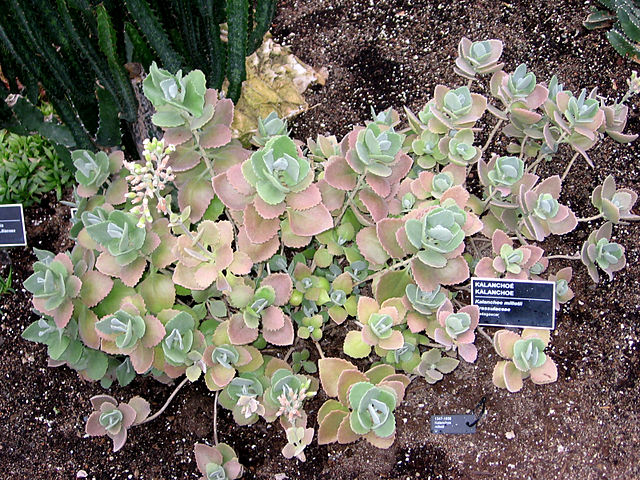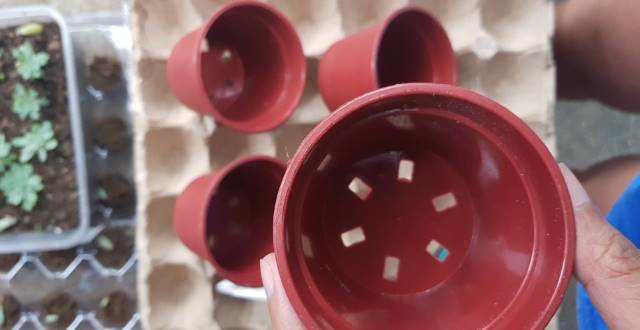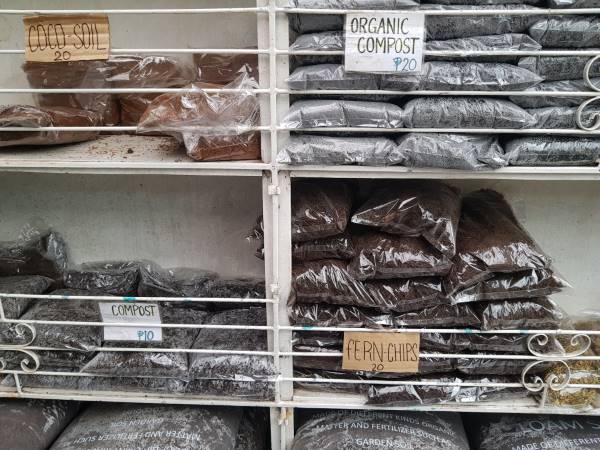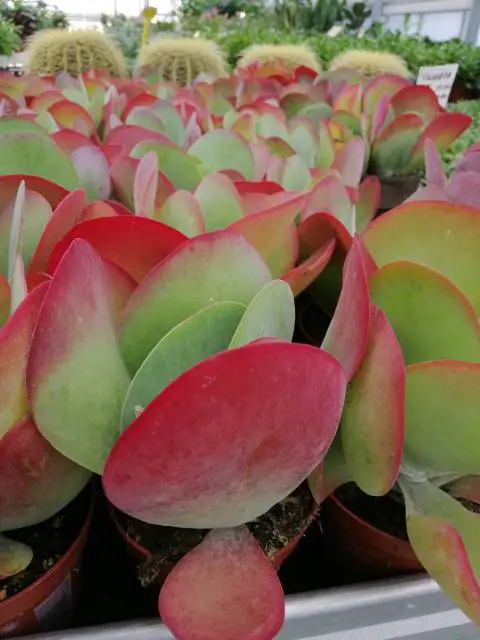Kalanchoe millotii is a lovely shrub succulent that grows up to 1 foot high. It is a member of the Crassulaceae family. Since it is not cold hardy it is mostly grown as an indoor plant in cold regions. It makes a great houseplant due to its low care requirements. Kalanchoe millotii is an ornamental succulent and is often used in rocky and succulent gardens and also in landscape designing.
Origin and Habitat
Kalanchoe millotii is native to Madagascar (an island country lying off the southeastern coast of Africa). The habitat of this plant is the Rocky Mountains and dry soils of Madagascar.
General features of Kalanchoe millotii
Millot Kalanchoe is a small perennial succulent. The succulent has a dense, bushy growth habit but as the plant grows it displays a branching growth habit. The succulent grows up to 1 ft (30 cm) tall.
It has ovate, light green colored leaves with scalloped edges. The leaves have a slightly fuzzy texture.

Millot Kalanchoe gives off numerous, tiny flowers that appear in clusters on long stalks above the succulent. Flowers are tiny, white, and appear like daisy flowers when open up.
Is Millot Kalanchoe an outdoor or indoor succulent?
Millot Kalanchoe can be grown in both indoor and outdoor conditions. In those regions areas where the temperature is warm and does not go below freezing, it is best to grow this succulent outside. In warmer zones, they can be included in rock and succulent gardens. They should be grown as indoor succulents in those regions where the temperature often goes below freezing.
How to grow and care for Kalanchoe millotii?
Millot Kalanchoe is easy to cultivate and maintain. It makes a great plant in any garden due to its low care requirements.
Keep reading to check out the useful tips for how to care for Millot Kalanchoe.
Light requirements
Sunlight is the most critical requirement for healthy growth of Kalanchoe succulents. Millot Kalanchoe needs lots of sunlight to grow well. Outdoor succulents can be planted in full sun to partial shade. In areas where the summer is extremely hot, and the sunlight is too intense they should be planted in partial shade.
Indoor succulents should be kept near a bright sunny window for ample sunlight exposure. In winter keep your succulents near a south-facing window, while in summer season move them near east or west-facing windows. Avoid direct contact with the windows during the summer season, when the sun is too intense it may cause the burning or scorching of the leaves.
Note: If your succulents start growing too tall or appear leggy or stretched out, it is an indication that it is not getting enough sunlight. If you experience this situation, move your indoor succulent near a bright sunny window.
Potting medium
Millot Kalanchoe requires a well-draining potting mix. You can use a special cactus mix or a succulent soil mix readily available in the market or prepare a potting mix at your own by mixing 40 to 50% grit (perlite and sand) with peat moss.
Coarse sand and perlite improve the drainage and aeration of the potting medium by increasing the soil porosity. A well-draining potting soil will not retain the moisture and prevent the roots from rot.
Avoid the use of a potting medium that is too clayey. A clayey soil will not have enough porosity to let the excess water drain out. This will ultimately lead to water build up in the potting medium, causing root rot and decay.
Temperature requirements
Kalanchoe millotii is hardy to 36 to 40-degree Fahrenheit temperature. It can be easily grown as an outdoor succulent in areas where the temperature is warm.
Millot Kalanchoe is a soft succulent and will not survive freezing temperatures. Below freezing temperature will cause frost injury and death in no time. If there is a risk of frost it is better to bring the potted plants indoors and place in a sunny windowsill or under artificial grow lights. If the succulents are grown in the garden soil it is better to cover them with frost clothes to protect from freezing weather. It has been reported that even a few hours of exposure to below freezing temperatures is enough to kill the succulents.
It can be grown outdoors in containers during the summer season and as an indoor succulent during the winter season.
Cold Hardiness Zones
Kalanchoe millotii can be grown as a hardy succulent in USDA zones 10b to 11b.
- USDA Zone 10b: (35-40 °F) 1.7 to 4.4 °C
- USDA Zone 11a: (40-45 °F) 4.4 to 7.2 °C
- USDA Zone 11b: (45-50 °F) 7.2 to 10 °C
Water requirements of Kalanchoe millotii
Kalanchoe millotii is a drought smart plant that can tolerate a period of neglect. The watering needs vary with the seasonal temperatures. Millot Kalanchoe needs moderate irrigation in the autumn and spring seasons, while during summer they need to be irrigated more frequently. In the summer season, the evaporation rate is very high due to hot weather, and the water is lost at a rapid rate from the soil. During winter they need occasional watering, irrigate only if the plant starts shriveling.
Water well and let it drain out of the drainage hole. Then wait for the soil to dry out completely before applying the next irrigation.
How to know when to water your succulents? Insert your finger in the soil if the top 1 to 2 inches are completely dried, it is the right time to water.
Though these succulents can survive a period of drought but do not neglect them for a long time. Water the succulents well as soon as the soil dries out to ensure their healthy growth.
Read More about watering Kalanchoe Succulents:
http://kalanchoe-succulent.com/when-to-water-kalanchoes/
Overwatering is the most commonly occurring problem causing the death of the succulents. Excess of water causes rotting and decay of roots; it also encourages fungal growth.
Humidity and Kalanchoe millotii
All varieties of Kalanchoe succulents can generally take all levels of humidity. The only thing that varies with the humidity is their watering needs. If the humidity is very high, the succulents need less water, while at low humidity they may need water more often. Though humidity does not impact the overall plant growth directly, however, high humidity can likely encourage the fungal growth on the succulents. Generally, the humidity at room temperature is just fine for the growth of Millot Kalanchoe.
Fertilization of Kalanchoe millotii
Though Kalanchoe millotii gets plenty of nutrition from the potting medium, it can be benefited from a moderate dose of some extra nutrients.
Fertilization is always a fun thing for enthusiast gardeners who want to make their plants grow luxuriantly. It is recommended to fertilize your succulents during the active growing phase biweekly or monthly with a light dose of cactus fertilizer or succulent fertilizer mix. Avoid fertilizing your succulents when they are in the dormant phase.
These succulents don’t need a lot of nutrients so, avoid the overdose of fertilizers.
How to propagate Kalanchoe millotii?
Kalanchoe millotii can be propagated by leaf and stem cuttings.
To take the cuttings use a clean sharp scissor or gardening shears. Gently cut the plant part you want to propagate. Let the cutting sit at a warm dry place for 2 to 3 days. It will allow the cuttings to develop callous at the cut end.
Fill the containers (in which you wish to propagate the succulents) with a standard succulent mix. Place the cuttings at the top of the pre-moistened potting soil (a mix sand, perlite, and peat moss). Keep misting the cuttings regularly 5 to 6 times a day and also keep the soil evenly moist. The cuttings need more water until they establish in the soil. But do not overwater it will rot the cuttings.
Put the pots near a window with indirect sunlight. Avoid exposure to bright direct sunlight until the succulents are established in the soil. The succulents will start rooting after 2 to 3 weeks and will be ready to transplant into new containers.
How often to repot Kalanchoe millotii?
Kalanchoe millotii does not need frequent repotting. It can thrive well in the same container for years. However, a general rule is to repot all Kalanchoe succulents every 2 years, it will provide a fertile potting medium to the succulents with plenty of nutrients. Even if your Kalanchoe has completed 2 years in the same container and is growing healthy still you should repot into new containers.
It is also recommended to repot in certain other conditions, for example, when the potting medium and the containers have poor drainage, the succulent is infested by insect pests or diseases, and when the container is too small for the succulent to grow and spread. It is also advised to repot every time you buy a new succulent from the market.
Does Kalanchoe millotii need pruning and grooming?
Kalanchoe millotii is a small shrub succulent that doesn’t grow too tall. Therefore, it doesn’t need pruning.
However, pruning to remove the spent blooms and dead leaves can encourage more blooming and healthy growth in the next growing season. Just take a clean scissor and snip off the spent blooms and dead leaves gently. Make sure you don’t injure any other part of the succulent. Pruning will also make your succulent look well-organized, neat, and tidy.
Read more about pruning here:
http://kalanchoe-succulent.com/pruning-kalanchoe-plants-how-and-when-to-prune/
Is Kalanchoe millotii poisonous?
Generally, all Kalanchoe succulents are toxic to pet animals, birds, and livestock. They must be kept out of the reach of toddlers because they can cause stomach upset.
Kalanchoe succulents contain cardiac glycosides that are toxic to pet animals. If you are keeping pets at home, it is advised to keep the succulents away from cats and dogs because if they eat up any plant part it can lead to serious consequences.
The pets will start developing several symptoms after ingestion such as diarrhea, vomiting, change in heart rate and rhythm, stomach upset or pain, and excessive slobbering.
If you observe any of the above-mentioned symptoms of poisoning take your pet immediately to an expert Veterinarian.
What are the problems of Kalanchoe millotii?
Kalanchoe millotii is quite tolerant to insect pests. Mealybugs and aphids can be occasionally observed attacking the indoor plants. However, these insects are not a very big problem. You can control the infestation easily if you are lucky enough to spot the problem at an early stage.
It is recommended to use 70 % isopropyl alcohol or neem oil spray to get rid of these tiny bugs. The stems and leaves of the succulent should be rubbed with isopropyl alcohol to keep the bugs away. If the infestation is very severe, you can use a non-toxic insecticide spray.
Another big problem with all Kalanchoe succulents is overwatering. You may experience this problem if you have accidentally ended up overwatering your succulent. Overwatering increases the chances of fungal diseases of the succulents. Therefore, optimize the use of water to save your succulents from the havocs of overwatering.
Feature photo Credit: Salicyna / CC BY-SA





